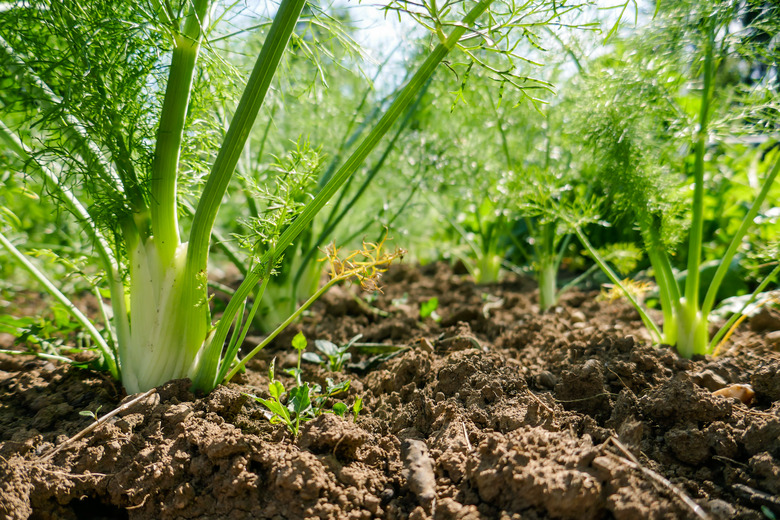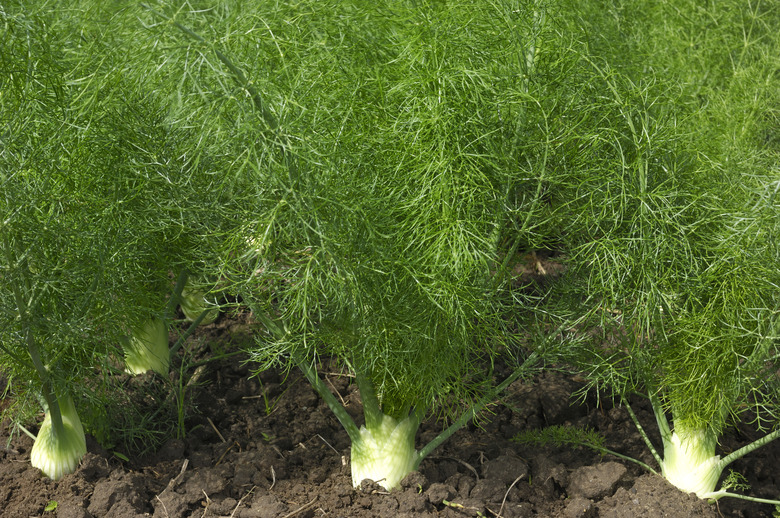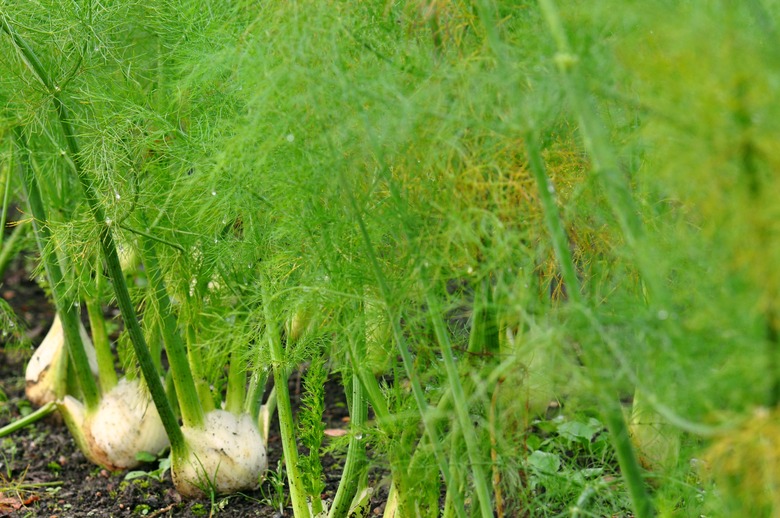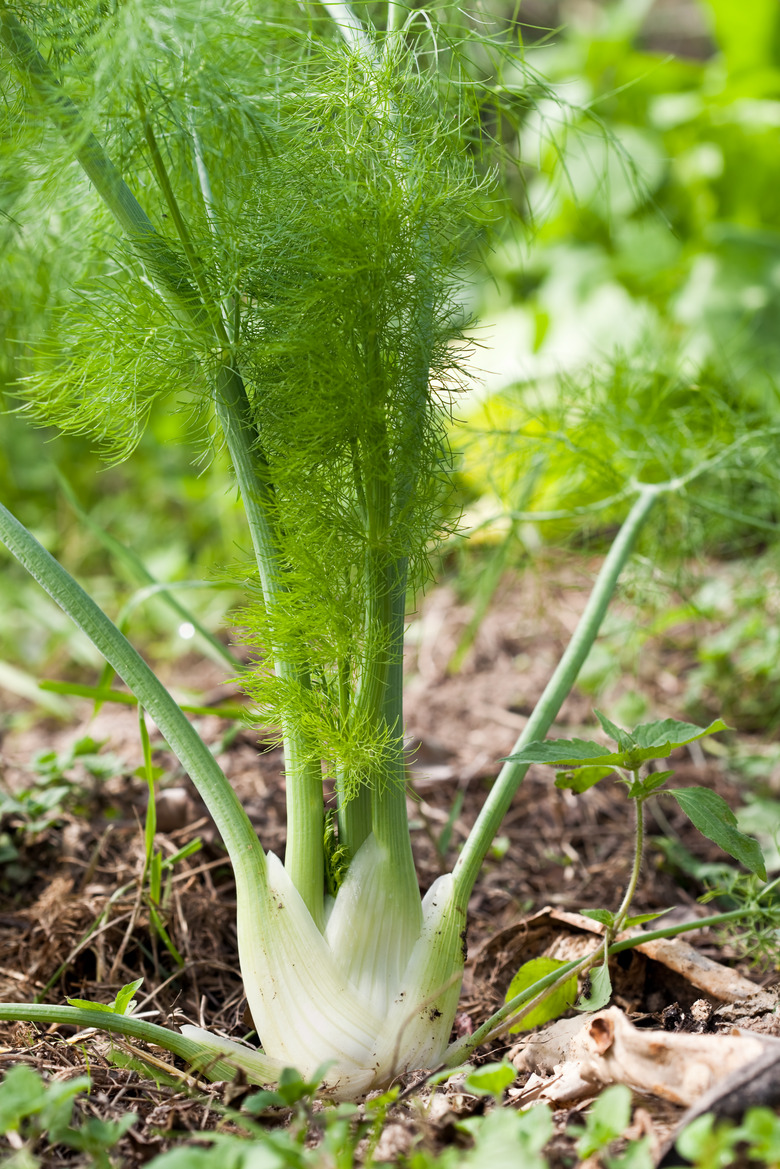How To Grow Fennel
We may receive a commission on purchases made from links.
Native to the Mediterranean and southeast Asia, common fennel (Foeniculum vulgare) is a branching perennial valued as much as an ornamental as it is for its delectable leaves, stems and seeds. If swallowtail butterflies could talk, they would tell you how much they enjoyed feasting on fennel stalks and leaves when they were caterpillars since fennel is one of their favorite host plants.
Common fennel, also known as sweet fennel, Florence fennel and finocchio, is one of several fennel species with a thick, bulbous, white stalk and wispy, bright-green leaves. Plants bloom with tiny, aromatic, yellow flowers that attract many other pollinators, including honeybees, bumblebees and various species of flies, wasps and beetles.
Attracting beneficial insects to your garden is just one reason for planting fennel. All parts of the plant are edible and have a mild, licorice-like flavor. The leaves are a favorite in salads, and fennel bulbs can be enjoyed raw, steamed or boiled. Besides that, it's a decorative plant that reaches a height of 4 to 6 feet and adds character to any garden. The seeds are medicinal as well as delicious.
Fennel is a DIY dream — an easy-to-grow, low-maintenance plant that loves full sun and moderately moist soil. It won't survive cold winters in some climates, and gardeners in northern climates often grow it as an annual. Fennel isn't native to North America, but having been established in the sunny grasslands it prefers, it outperforms many native species. While not every state considers it invasive as California does, it's definitely an aggressive grower.
Best Uses for Fennel
Best Uses for Fennel
Some people consider fennel an herb, while others consider it a vegetable, and both are true. When used as a seasoning for salads, fennel leaves add a subtle licorice flavor, and chewing raw fennel bulbs is said to be beneficial for digestion. Fennel seed is one of the oldest spices in the world, used for at least 5,000 years, and it is an integral part of Indian and Asian recipes. The combination of star anise, Szechuan peppercorns, cloves, cinnamon and fennel is known as Chinese five-spice powder and is used to flavor rice, vegetables and even cakes.
Like anise, fennel seeds are full of the essential oil anethole, from which the licorice flavor comes, and they have a number of medicinal uses. They have traditionally been used as a cough remedy, and they can help with gastrointestinal problems and bloating. Consequently, fennel is a natural addition to your herb garden, and because it grows tall, it's usually placed at the back, where its delicate foliage can stretch out.
Fennel can also hold its own as a purely decorative plant and can be combined with herbaceous perennials to form a border or a cottage garden. The fine texture of its leaves and flowers combines well with the coarser texture of other plants, creating an ethereal and showy partner for more down-to-earth species, such as coneflowers (Echinacea spp.). You can grow fennel in pots to adorn your entryway, but because the plant has deep roots, it does best when planted in the ground.
How to Grow Fennel
How to Grow Fennel
- Common Name: Fennel
- Botanical Name: Foeniculum vulgare
- When to Plant: Early spring to late summer. Later plantings produce juicier stalks.
- USDA Zones: 4 through 9, winter hardiness according to cultivar
- Sun Exposure: Full sun
- Soil Type: Moist, well-draining soil
- When it's in Trouble: Fennel has few natural pests and diseases but will turn brown if overwatered.
- When it's Thriving: Produces a white, tennis-ball-sized bulb with bright-green leaves and yellow flowers.
Starting Fennel From Seed
You can start fennel from seeds you buy in the spice section of the grocery store, although buying seeds from a reputable seed supplier offers more assurance that you'll be growing healthy, disease-free plants as well as seeds that reliably germinate. You can either sow them in modular trays and transplant the seedlings after four to six weeks, or you can sow seeds directly in the ground. Sowing into the ground is preferable because fennel doesn't like to have its roots disturbed. The ideal soil temperature is 70 degrees Fahrenheit, but the seeds will sprout at any temperature between 60 and 90 degrees.
When direct-seeding, you can sow them in rows that are 18 inches apart with each row consisting of 10 seeds per foot or in stations separated by 12 inches, each consisting of three seeds. Cover each seed with 1/8 to 1/2 inch of soil because they need to be in the dark to germinate, and when the seedlings emerge, thin the weakest ones to leave the strongest ones spaced 6 to 12 inches apart. Instead of pulling the weakest seedlings by the roots, which will disturb the roots of the ones you want to keep, remove them by pinching the stalks.
The soil must be kept moist, so if the ground is dry, wet it down before sowing the seeds and water regularly. The seedlings take seven to 10 days to emerge. You can improve the chances of success by sprouting the seeds in moist paper towels and sowing them outside when the first root emerges from the seed heads.
Starting Fennel From a Seedling
Because fennel has a long taproot that doesn't like to be disturbed, fennel seedlings should ideally be planted in biodegradable modules or plugs so they can be transferred directly into the ground without removing them from the pots. Sow three seeds 1/4 inch deep in 1 1/2- to 2-inch-deep cells and remove the two weakest seedlings when they emerge, leaving only one seedling per cell.
The best time for transplanting is midspring to late summer, when the seedlings are 3 to 4 inches tall and four to six weeks old. If they are allowed to grow any larger than that, the seedlings will become root bound and won't perform as well in the ground. Transplants should be spaced 6 to 12 inches apart in rows separated by 18 inches.
In What Zone Does Fennel Grow Best?
In What Zone Does Fennel Grow Best?
Fennel originated in the Mediterranean, and it prefers warm, sunny climates with short winters and no hard freezes. In North America, it grows best in USDA plant hardiness zones 7 through 9, although some cultivars can handle the cold weather to zone 4. Although it won't survive the winter in many regions, it can be successfully cultivated as an annual and harvested when the bulb reaches the size of a tennis ball.
In all zones, the bulbs become juicier when the seeds are sown in midsummer because the days aren't lengthening, which encourages bolting (going to seed prematurely), and more moisture is available in the early fall. An early planting is recommended when you plan to harvest seeds or establish the plants as perennials. The plants typically flower about 90 days after planting, and some gardeners like to shake the pollen off the flowers and collect it in a paper bag to use for seasoning.
When Should You Plant Fennel?
When Should You Plant Fennel?
Fennel prefers the cooler days of spring and early autumn over the hot days of summer, so the best time to plant it is in the early spring or late summer. If you plant it in spring, you can harvest the seeds and pollen from the flower heads in mid to late summer and cut back the stalks at ground level, and the plant may regrow in time for you to harvest the succulent new stalks before the first frost. A late-summer planting is recommended if you're only interested in harvesting the stalks.
Planting fennel as a perennial depends on your hardiness zone. Your local cooperative extension service can recommend a cultivar that is best for your zone. Because fennel craves sun, the growing season begins when the number of cloudy and rainy days is at the minimum, which is usually from early to late summer, although care should be taken to plant well before the summer heat raises the soil temperature. If conditions are dry, be sure to water regularly to ensure the plants get the moisture they need.
Soil, Sunlight and Water Recommendations for Fennel
Soil, Sunlight and Water Recommendations for Fennel
Fennel likes to be in full sun, but it's really a cool-weather plant and does best on moist soil and in moderate temperatures. This is why it's best to start seeds or plant seedlings in early spring or late summer rather than in the heat of full summer, when the soil may be parched. You can mitigate dry soil somewhat by adding mulch to help it retain moisture and adding organic matter such as compost, which also helps retain moisture and provides some nutrients.
Moderately acidic to neutral soil with a pH between 5.5 and 6.8 is best. The soil needs to be well-draining, so if it's compacted, you'll probably want to break it up with a tiller before sowing seeds or planting seedlings. It must be able to hold moisture, so sandy soil may need to be amended with organic matter to ensure a vital crop. Water regularly once the seeds or seedlings are planted, but don't overdo it because one of the main problems with fennel is that it suffers root rot if it gets too much water.
How to Propagate Fennel
How to Propagate Fennel
Because fennel grows so easily from seeds, all you really need to do to successfully propagate it is wait for the seeds to drop, collect them and sow them the following season. Transplanting fennel from the ground into pots for winter growing isn't an option because the taproot is so sensitive.
How to Winterize Fennel
How to Winterize Fennel
Fennel can survive light frosts, so if you live in zones 6 to 9, you can leave your fennel plants outdoors during the winter. If you live in zones 4 and 5, be sure to choose a cultivar that's cold-hardy in your climate. If you grow fennel in containers, you'll need to bring them indoors during the winter months and place them in a sunny spot.
How to Harvest Fennel
How to Harvest Fennel
You should harvest fennel when the bulb is about the size of a tennis ball. If you let it get any larger, it will lose some of its licorice flavor and develop a bitter taste. To harvest the entire plant, cut the bulb off the root at ground level, leaving the root in the ground to continue producing smaller bulbs until the end of the season.
Common Pests and Other Problems for Fennel
Common Pests and Other Problems for Fennel
The most common pests that affect fennel are aphids, which collect on the leaves and excrete a sticky substance known as honeydew, which attracts ants and if left untreated promotes the growth of sooty mold. You can usually remove aphids by spraying the leaves with a strong jet of water, and to prevent them from returning, mulch with a shiny material, such as bits of tin foil or colored plastic. Treat severe infestations by using a spray that contains neem oil.
Slugs love to dine on fennel stalks, and they tend to hide in thick foliage awaiting their chance to dine. You can remove these by hand; trap them with small cups of beer, milk or a yeast and sugar solution; or spread diatomaceous earth around the plants. Slugs avoid diatomaceous earth because it lacerates their soft, unprotected bellies.
You'll probably also find caterpillars on your fennel plants, particularly those of the swallowtail butterfly. They will eat some of the leaves, but if you love butterflies (who doesn't?), you probably won't consider them pests.
Common Diseases for Fennel
Common Diseases for Fennel
Fennel is a hardy plant that doesn't succumb easily to disease, but like all plants, it is vulnerable to fungal infections, which produce flecks or discoloration on the leaves and can rot the roots. These fungal diseases include:
- Cercospora leaf blight, which causes brown necrotic spots on the leaves that eventually wither and die.
- Downy mildew, a feathery growth on the underside of the leaves.
- Powdery mildew, which can inhibit flower growth.
- Rust, which stunts the growth of the plant.
- Root rot, which is caused by overwatering or poorly draining soil and eventually kills the plant.
Many of these diseases are the result of overcrowding plants or infected seeds. In some cases, treatment with a fungicide spray helps, especially in the case of leaf blight and rust, but fungal problems are best avoided by sowing pathogen-free seeds, spacing plants appropriately and avoiding overwatering.



